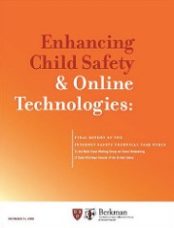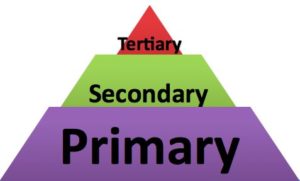Note the phrase “social media safety” in the headline. There are many more milestones in Internet safety education overall, but here are two vital ones for youth safety in social media since its early days in the middle of the last decade:

Milestone 1: the finding of the Berkman Center’s Internet Safety Technical Task Force (now Berkman Klein Center) that not all young people are equally at risk online, and it’s usually the kids most at risk offline who are most vulnerable online as well. The underlying reason for this reality is another finding of our task force through its very comprehensive review of the youth online risk research: that a child’s psychosocial makeup and home and school environments are better predictors of online risk than any technology or media a child uses. [For more on this, here‘s my post about the task force’s report.]
Milestone 2: the public health field’s Levels of Prevention, adopted by the risk prevention field and equally applicable to Internet risk prevention, based on the ISTTF’s finding about varying levels of risk. Presented by risk prevention expert and author Patricia Agatston, PhD, to the U.S.’s next national task force on the subject, the Online Safety & Technology Working Group in 2009, the levels are simply “Primary, Secondary, and Tertiary” (here‘s my post about our 2010 report to Congress, “Youth Safety on a Living Internet“). For Internet safety, here’s what the levels look like:
 “Primary” represents basic prevention education for all youth (e.g., digital literacy, media literacy and – now that media is social – social literacy, aka social-emotional learning for all students, pre-K-12). Among the recommendations in our report to Congress, we called for universal instruction in digital citizenship and media literacy, K-12, throughout the school day and curriculum. That was ambitious, but it was our task force’s way of sending the message that these represent baseline, universal prevention education in a digital age. A lot of work has been done on what media literacy now needs to cover – particularly by Project New Media Literacies, which started at MIT and moved to University of Southern California when its founders, Prof. Henry Jenkins (who also testified before our task force) and Erin Reilly, moved their work to USC. “Digital citizenship” still hasn’t fully been defined and doesn’t have the body of research behind it that media literacy has, so my work has increasingly focused on the three literacies called for by today’s very social digital media as baseline prevention education for all children.
“Primary” represents basic prevention education for all youth (e.g., digital literacy, media literacy and – now that media is social – social literacy, aka social-emotional learning for all students, pre-K-12). Among the recommendations in our report to Congress, we called for universal instruction in digital citizenship and media literacy, K-12, throughout the school day and curriculum. That was ambitious, but it was our task force’s way of sending the message that these represent baseline, universal prevention education in a digital age. A lot of work has been done on what media literacy now needs to cover – particularly by Project New Media Literacies, which started at MIT and moved to University of Southern California when its founders, Prof. Henry Jenkins (who also testified before our task force) and Erin Reilly, moved their work to USC. “Digital citizenship” still hasn’t fully been defined and doesn’t have the body of research behind it that media literacy has, so my work has increasingly focused on the three literacies called for by today’s very social digital media as baseline prevention education for all children.- “Secondary” is more targeted and situational prevention ed provided when problems arise, from specific bullying prevention instruction to making use of incidents of bullying, online harassment or conflict as “teachable moments” for forming restorative practice circles or otherwise addressing problems in restorative, evidence-based ways.
- “Tertiary” is targeted prevention as well as intervention for the much smaller population of youth with established patterns of risky behavior and conditions in their lives – for example, children dealing with trauma in their homes and communities. Of course, as for restorative practices and other specialized intervention, this level of care requires trained expertise, such as that of school social workers, psychologists and other risk prevention specialists. At this level, the experts themselves need some training – in the media that are so much a part of their young clients’ everyday lives. That is so the intervention can happen wherever students are: in digital as well as physical spaces.
It’s high time for “Internet safety” to get a little more granular. Social media safety can’t be one-size-fits-all. It needs to be mapped to the different risk levels of the people it aims to support.

Leave a Reply